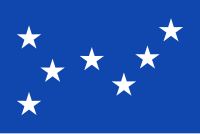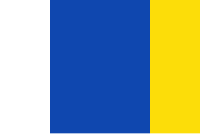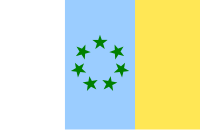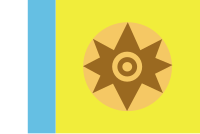Canarian nationalism

Canarian nationalism is a political movement that encourages the national consciousness of the Canarian people. The term includes several ideological trends, ranging from a demand for further autonomy within Spain to the right to self-determination.
Self-government through history[edit]
The origins of the Canarian people started with the Spanish conquest of the islands, when the local Guanche Berber[citation needed] population[1] were conquered and eventually assimilated and European-style manorialism introduced in most of the islands.[2]
During the last days of the conquest, on 30 May 1481, an aboriginal leader from Gran Canaria called Tenesor Semidán (afterwards baptized as Fernando Guanarteme) signed a peace treaty with Fernando II of Aragon, in the so-called Carta de Calatayud.[3] This treaty defined the archipelago as a kingdom within the Spanish monarchy, establishing the legal framework for its administration and its relationship with Spain.[4]
The pact signed in Calatayud granted the rights and duties that would shape the Canarian fuero (Fuero de Canarias), which would soon be used in institutions such as the Cabildos and the Canarian Court (Audiencia de Canarias). Notable rights stated in the fuero included an autonomous treasury and army, and the continuity of traditional Canarian customs and roles. The Canary Islands had its own currency[which?] until 1776.[5]
Initially only Gran Canaria accepted the pact, but one by one the whole group of islands eventually consented to the agreement.[6]
Spain failed to fulfill the pact several times, a failure that resulted in the uprisings of 1502 (Ichasagua), 1770 (La Aldea), and 1778 (Arico).[7]
The pact was finally discarded during the Restoration.[8]

Beginnings of organized nationalism[edit]
The first nationalist organizations were born in the 19th century as part of a local labour movement. Some of its proponents were José Cabrera Díaz, Nicolás Estévanez and Secundino Delgado. Delgado is considered today as the father of the Canarian nationalism.
The earliest nationalist parties were the Partido Popular (Autonomista), founded in 1901 in Santa Cruz de Tenerife, and the Canarian Nationalist Party, founded in 1924 in exile in Cuba.[6]
During the Second Spanish Republic Canarian nationalism went unnoticed; although an autonomy statute was proposed, the Spanish Civil War blocked hopes for autonomy.


During the dictatorship[edit]
Francoism fiercely oppressed any kind of regional nationalism in Spain and its colonies. However, the 1960s were years known for the activism of various groups. In 1959 the movement Canarias Libre acquired some notoriety, and in 1964, Antonio Cubillo founded the MPAIAC (Movement for the Self-determination and Independence of the Canarian Archipelago). The MPAIAC created the flag of the seven green stars that is accepted by the nationalist movement as a whole today.
During the last days of Francoism the DAC (Destacamentos Armados Canarios) and the FAG (Fuerzas Armadas Guanches), movements attached to Canarian nationalism, committed terrorist acts. Although the movements had initially attracted sympathies, the violent terror actions and the "armed struggle" spearheaded by Cubillo's MPAIAC brought about a general rejection among local Canarios.[9]
One of the factors leading to the 1977 Tenerife airport disaster, the most deadly accident in aviation history, was a bomb exploded by Canarian separatists in Gran Canaria Airport.
Spanish democracy[edit]

Since 1982 the Canary Islands have had a statute of autonomy, which defines the archipelago as a nationality of Spain.
In the 1980s a nationalist-like party called UPC (Canarian People's Union) was the third-most-voted party in Canary Islands. In 1985 Antonio Cubillo returned from Algiers and founded the National Congress of the Canaries (CNC).[10]
Since 1993, the nationalist party Canarian Coalition has held the government of the islands.[11]
Current situation[edit]
At present, many sorts of parties, trade unions and associations describe themselves as "nationalist," some of which support the Berberist cause.
The nationalist parties include CC (Canarian Coalition), NC (Nueva Canarias),[12] FREPIC-AWAÑAK (Popular Front of the Canary Islands), CCN (Nationalist Canarian Centre),[13] ANC (Canarian Nationalist Alternative),[14] Azarug,[15] Partido Nacionalista Canario[16] Alternativa Popular Canaria, Alternativa Maga Nacionalista,[17] and UP (Unidad del Pueblo).
There are also nationalist trade unions such as FSOC (Frente Sindical Obrero Canario), IC (Intersindical Canaria), as well as revolutionary organizations, like Inekaren.[18] Some radical groups use the word Taknara to refer to the Canary Islands, but other nationalists do not agree with this name.[19]
The movement has recently undergone a modest renaissance. The popular newspaper of the islands El Día has changed its editorial line to fit the nationalists' cause. In its pages it is normal to read the opinion of historical nationalist activists. In particular the "Project for a Federal Canarian Republic", written by Antonio Cubillo, has created a stir and a media debate.[20]
References[edit]
- ^ Hupalupa, Magos, Maúros, Majoreros or Amasik
- ^ Abreu Galindo, Historia de La Conquista de las siete Islas de Canaria
- ^ Ovetense ("y así se le hizo su bautismo con gran solemnidad, como a persona real").
- ^ Juan Bethencuort Alfonso, Historia del Pueblo Guanche, vol 2
- ^ Abreu Galindo, ("Que todas las franquezas y libertades que tenían, se le guardarían").
- ^ a b El pacto para Tenerife, Juan Bethencuort Alfonso, Historia del Pueblo Guanche, tomo III
- ^ Juan Bethencuort Alfonso, Historia del Pueblo Guanche, vol 3
- ^ "El Pacto de Calatayud; Soberanía y Colonialismo en Canarias". Archived from the original on 16 May 2011. Retrieved 20 March 2015.
- ^ Ancor Dorta. "Mencey Macro: 1975-1980 Años convulsos en la hístoria de Canarias". Retrieved 20 March 2015.
- ^ "Elguanche.net". Retrieved 20 March 2015.
- ^ "Coalición Canaria - Un gran pueblo, una gran voz". Archived from the original on 20 March 2015. Retrieved 20 March 2015.
- ^ "Nueva Canarias". Archived from the original on 2007-09-28. Retrieved 2007-10-10.
- ^ "Centro Canario Nacionalista - CCN". Facebook. Retrieved 20 March 2015.
- ^ "Alternativa Nacionalista Canaria". Archived from the original on 16 March 2014. Retrieved 20 March 2015.
- ^ "Las JCNC muestran su solidaridad con Azarug". Archived from the original on 2013-08-01. Retrieved 2012-03-06.
- ^ "Narias.com is available at DomainMarket.com". Retrieved 20 March 2015.
- ^ "Pagina nueva 1". Retrieved 20 March 2015.
- ^ "Inekaren - Noticias". Retrieved 20 March 2015.
- ^ "Antonio Cubillo Ferreira, About the made up name Taknara...". Archived from the original on 2021-06-24. Retrieved 2012-03-08.
- ^ "El Día". Archived from the original on 2014-12-18. Retrieved 2020-07-12.
Bibliography[edit]
- Luis Pérez Aguado, Revista Aguayro nº 228.
- Pedro Cullen del Castillo, Torre de Gando.
- Africo Amasik, El Arbol de La Nación Canaria.
- 3.000 años de canariedad, AMAGA, Alternativa Maga Nacionalista.


 French
French Deutsch
Deutsch